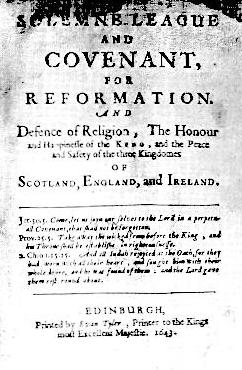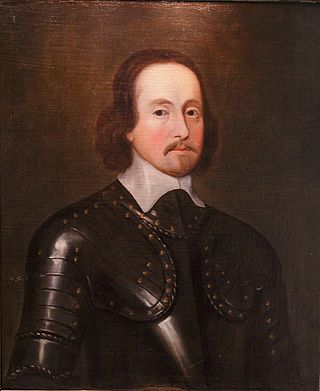
The English Civil War refers to a series of civil wars and political machinations between Royalists and Parliamentarians in the Kingdom of England from 1642 to 1651. Part of the wider 1639 to 1653 Wars of the Three Kingdoms, the struggle consisted of the First English Civil War, the Second English Civil War and the Third English Civil War. The latter is also known as the Anglo-Scottish war, since most of the fighting took place in Scotland.

The Solemn League and Covenant was an agreement between the Scottish Covenanters and the leaders of the English Parliamentarians in 1643 during the First English Civil War, a theatre of conflict in the Wars of the Three Kingdoms. On 17 August 1643, the Church of Scotland accepted it and on 25 September 1643 so did the English Parliament and the Westminster Assembly.

The Irish Confederate Wars, also called the Eleven Years' War, took place in Ireland between 1641 and 1653. It was the Irish theatre of the Wars of the Three Kingdoms, a series of civil wars in the kingdoms of Ireland, England and Scotland – all ruled by Charles I. The conflict had political, religious and ethnic aspects and was fought over governance, land ownership, religious freedom and religious discrimination. The main issues were whether Irish Catholics or British Protestants held most political power and owned most of the land, and whether Ireland would be a self-governing kingdom under Charles I or subordinate to the parliament in England. It was the most destructive conflict in Irish history and caused 200,000–600,000 deaths from fighting as well as war-related famine and disease.

David Leslie, 1st Lord Newark was a Scottish military officer and peer. During the Thirty Years' War, he joined in the Swedish Army in 1630 and served under Alexander Leslie. Returning to Scotland in the final days of the Bishops' War, Leslie fought in the English Civil War and Scottish Civil Wars on the side of the Covenanters and Royalists. After the Stuart Restoration, Leslie was raised to the peerage of Scotland as Lord Newark by Charles II of England.

The Wars of the Three Kingdoms, sometimes known as the British Civil Wars, were a series of intertwined conflicts fought between 1639 and 1653 in the kingdoms of England, Scotland and Ireland, then separate entities united in a personal union under Charles I. They include the 1639 to 1640 Bishops' Wars, the First and Second English Civil Wars, the Irish Confederate Wars, the Cromwellian conquest of Ireland and the Anglo-Scottish war (1650–1652). They resulted in victory for the Parliamentarian army, the execution of Charles I, the abolition of monarchy, and founding of the Commonwealth of England, a unitary state which controlled the British Isles until the Stuart Restoration in 1660.
This is a timeline of events leading up to, culminating in, and resulting from the English Civil Wars.

The Anglo-Scottish war (1650–1652), also known as the Third Civil War, was the final conflict in the Wars of the Three Kingdoms, a series of armed conflicts and political machinations between shifting alliances of religious and political factions in England, Scotland and Ireland.

The First English Civil War took place in England and Wales from 1642 to 1646. It is part of the 1639 to 1653 Wars of the Three Kingdoms, which also include the Bishops' Wars, the Irish Confederate Wars, the Second English Civil War, the Anglo-Scottish war (1650–1652) and the Cromwellian conquest of Ireland. Historians calculate some 15% to 20% of all adult males in England and Wales served in the military between 1639 and 1653, while around 4% of the total population died from war-related cause, versus 2.23% in World War I. These figures illustrate the impact of the conflict on society in general, and the bitterness it engendered.

Confederate Ireland, also referred to as the Irish Catholic Confederation, was a period of Irish Catholic self-government between 1642 and 1652, during the Eleven Years' War. Formed by Catholic aristocrats, landed gentry, clergy and military leaders after the Irish Rebellion of 1641, the Confederates controlled up to two-thirds of Ireland from their base in Kilkenny; hence it is sometimes called the "Confederation of Kilkenny".

The Cromwellian conquest of Ireland or Cromwellian war in Ireland (1649–1653) was the re-conquest of Ireland by the forces of the English Parliament, led by Oliver Cromwell, during the Wars of the Three Kingdoms. Cromwell invaded Ireland with the New Model Army on behalf of England's Rump Parliament in August 1649.

Between 1639 and 1652, Scotland was involved in the Wars of the Three Kingdoms, a series of wars starting with the Bishops' Wars, the Irish Rebellion of 1641, the English Civil War, the Irish Confederate Wars, and finally the subjugation of Ireland and Scotland by the English Roundhead New Model Army.

Sir John Urry, also known as Hurry, was a Scottish professional soldier who at various times during the Wars of the Three Kingdoms fought for Scots Covenanters, Engagers and Royalists, as well as both English Parliamentarians and Royalists. Captured at Carbisdale in April 1650, he was executed in Edinburgh on 29 May 1650.

The Battle of Inverkeithing was fought on 20 July 1651 between an English army under John Lambert and a Scottish army led by James Holborne as part of an English invasion of Scotland. The battle was fought near the isthmus of the Ferry Peninsula, to the south of Inverkeithing, after which it is named.

The Treaty of Breda (1650) was signed on 1 May 1650 between Charles II, exiled king of England, Scotland and Ireland, and the Scottish Covenanter government. Under its terms, they agreed to install Charles II as King of Scotland and Britain, while Charles undertook to establish a Presbyterian Church of England, and guarantee the rights of the Church of Scotland.

Lieutenant-General Michael Jones, c. 1606 to 10 December 1649, was an Irish-born soldier of Welsh descent who fought for Parliament and the Commonwealth in the War of the Three Kingdoms, primarily in Ireland. Third son of Lewis Jones, Bishop of Killaloe, his brothers Henry and Ambrose were also bishops in the Protestant Church of Ireland.

The Battle of Lisnagarvey was fought on 6 December 1649, near Lisnagarvey during the Irish Confederate Wars, an associated conflict of the 1638 to 1651 Wars of the Three Kingdoms. Forces loyal to the Commonwealth of England defeated an army supporting Charles II of England, composed of Royalists and Scots Covenanters.
Presented below is a chronology of the major events of the Irish Confederate Wars from 1641 to 1653. This conflict is also known as the Eleven Years War. The conflict began with the Irish Rebellion of 1641 and ended with the Cromwellian conquest of Ireland (1649–53).
Colonel John Cockburn was an officer in the Scottish Covenanter army in the late 1640s and early 1650s during the Wars of the Three Kingdoms. In this capacity he led Lowland soldiers against Montrose's Scottish Royalist forces during the First English Civil War (1642-1646), when the Covenanter parliament of Scotland was allied with the English Parliamentarians against King Charles I. Colonel Cockburn led the colourfully defiant but futile Scottish resistance at Hume Castle during the Third English Civil War (1649-1651), when a Parliamentary army led by Oliver Cromwell invaded Scotland after its Covenanter government had made an uneasy alliance with King Charles II.

The siege of Dundee took place from 23 August to 1 September 1651 during the 1650 to 1652 Anglo-Scottish war, with English Commonwealth forces under George Monck confronting a garrison commanded by Robert Lumsden. After a two-day artillery bombardment, the town was captured and looted on 1 September, with an estimated 100 to 500 killed, including Lumsden.
The following outline is provided as an overview of and topical guide to the wars of the Three Kingdoms:

















